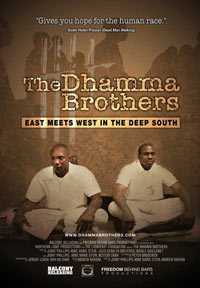[vc_row][vc_column][vc_column_text]
Donaldson Correctional Facility is situated in the Alabama countryside southwest of Birmingham. 1,500 men, considered the state’s most dangerous prisoners, live behind high security towers and a double row of barbed and electrical wire fences.
Within this dark environment, a spark was ignited. A growing network of men had been gathering to meditate on a regular basis. Intrigued by this, Jenny Phillips, cultural anthropologist and psychotherapist, first visited Donaldson Correctional Facility in the fall of 1999. She planned to observe the meditation classes facilitated by inmates and to interview the inmate meditators about their lives as prisoners.
As she met with the men, one by one in the privacy of an office, she was drawn in by their openness and willingness to talk freely about themselves. High levels of apprehension, distraction and danger characterize their lives as prisoners. Even though many of these men will never be released from prison, they were thirsty for meaningful social and emotional change. What she heard there was difficult to forget. It left her wondering if it were possible to live with a sense of inner peace and freedom within this harsh prison environment.
“In silence, the mind naturally turns within
to observe its own nature.”
– Rick Smith, Dhamma Brother
As a meditator herself, Jenny knew that meditation directly addresses the issue of personal suffering, and offers a simple yet powerful means for obtaining relief. But were these ancient ideas, as described in the teachings of the Buddha 2600 years ago, now relevant? Could the framework of this approach to suffering be translated into some basic principles of treatment that would be applicable to 21st century North American prisoners? Were these prisoners, many of them survivors of personal trauma, even capable of withstanding the emotionally and physically demanding experience of a Vipassana program requiring over 100 hours of silent meditation?
The Dhamma Brothers tells a dramatic story of human potential and transformation as it closely follows and documents the stories of a group of prisoners as they enter into this arduous program. It will challenge assumptions about the very nature of prisons as places of punishment rather than rehabilitation. Despite the difficulty in obtaining permission to film inside a prison, the Alabama Department of Corrections allowed a film crew to document, not only the Vipassana program, but many other scenes and settings revealing the daily lives of prisoners and staff.
“A wonderful, powerful, and unsentimental film about
incarcerated men getting below the surface of things. The freedom
and community they find sitting on meditation cushions in an
Alabama prison is a rare inspiration to all of us.”
– Richard Gere
Before the Vipassana retreat, the men openly express fear and trepidation, wondering what they will find when they look deeply within and face the consequences of past actions and trauma. They are shown packing their scant belongings and preparing for the journey inside, a very short walk down the prison corridor but a sea change in their lives as prisoners. We observe the transformation of the prison gym, a frequent site for violent battles among inmates, into a monastery, a separate, restricted place in which the inmate students can eat, sleep, and meditate in total seclusion from the rest of prison society.
The Vipassana teachers, Bruce and Jonathan, prepare to live and meditate with the inmates. Teachers and inmates, men from culturally different worlds, are locked together in a dramatically revealing process. This is, most likely, the first time non-inmates have ever lived among inmates inside a prison.
Seated on meditation mats on a red rug donated by the Warden, wrapped in navy blue blankets, the men sit still in silence as they journey inside. Their days are punctuated by a strict daily routine of eating, sleeping and meditating.
After the Vipassana retreat, the men tell their tales of pain and self-discovery. The spiritual warriors of Donaldson Correctional Facility discuss their collective experiences and vow to try to maintain their nascent sense of solidarity. In the nameless, faceless anonymity of prison life, where daily life is organized around social control and punishment, Vipassana has offered an alternative social identity based on brotherhood and spiritual development.
The stories of the men at Donaldson Correctional Facility are those of the unseen, unheard, and underserved. This film shines a spotlight upon society’s outcasts and untouchables as we witness them on their Odyssean journey into their misery to emerge with a sense of peace and purpose.
“Well, it is over. But the vibrations are still here. The memories of those last 10 days on the mat, the experiential wisdom which was gained, and all the prospects of peace which were found here, that is always going to linger.”
– Benjamin “OB” Oryang, Dhamma Brother
Source: The Dhamma Brothers Movie[/vc_column_text][/vc_column][/vc_row][vc_row][vc_column][vc_video link=”https://www.youtube.com/watch?v=QR7CbbcIzLc”][/vc_column][/vc_row]
